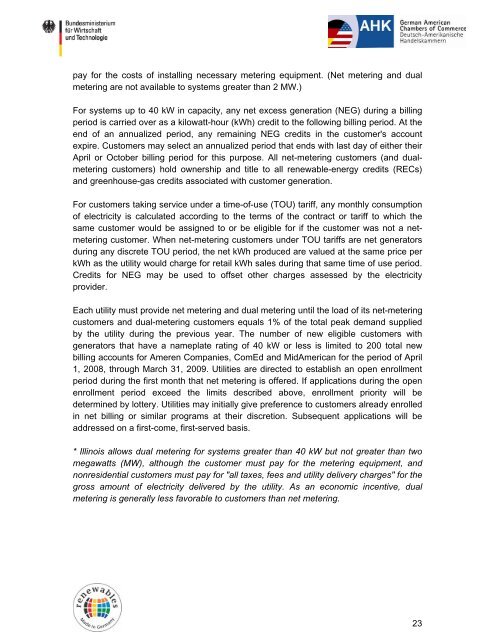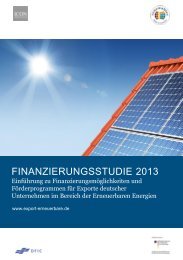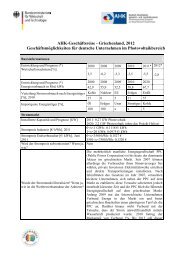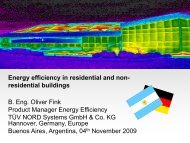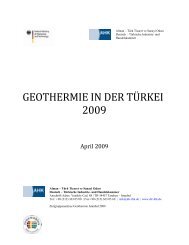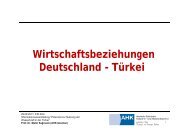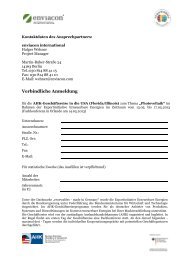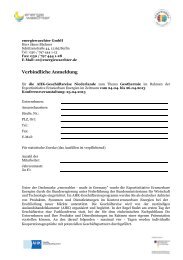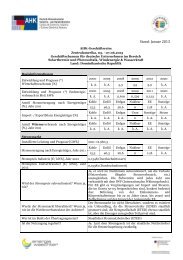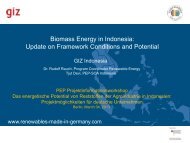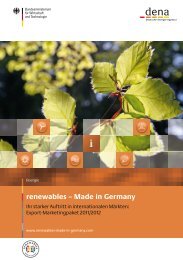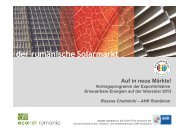PDF: 1,1 MB - Exportinitiative Erneuerbare Energien
PDF: 1,1 MB - Exportinitiative Erneuerbare Energien
PDF: 1,1 MB - Exportinitiative Erneuerbare Energien
- No tags were found...
You also want an ePaper? Increase the reach of your titles
YUMPU automatically turns print PDFs into web optimized ePapers that Google loves.
pay for the costs of installing necessary metering equipment. (Net metering and dual<br />
metering are not available to systems greater than 2 MW.)<br />
For systems up to 40 kW in capacity, any net excess generation (NEG) during a billing<br />
period is carried over as a kilowatt-hour (kWh) credit to the following billing period. At the<br />
end of an annualized period, any remaining NEG credits in the customer's account<br />
expire. Customers may select an annualized period that ends with last day of either their<br />
April or October billing period for this purpose. All net-metering customers (and dualmetering<br />
customers) hold ownership and title to all renewable-energy credits (RECs)<br />
and greenhouse-gas credits associated with customer generation.<br />
For customers taking service under a time-of-use (TOU) tariff, any monthly consumption<br />
of electricity is calculated according to the terms of the contract or tariff to which the<br />
same customer would be assigned to or be eligible for if the customer was not a netmetering<br />
customer. When net-metering customers under TOU tariffs are net generators<br />
during any discrete TOU period, the net kWh produced are valued at the same price per<br />
kWh as the utility would charge for retail kWh sales during that same time of use period.<br />
Credits for NEG may be used to offset other charges assessed by the electricity<br />
provider.<br />
Each utility must provide net metering and dual metering until the load of its net-metering<br />
customers and dual-metering customers equals 1% of the total peak demand supplied<br />
by the utility during the previous year. The number of new eligible customers with<br />
generators that have a nameplate rating of 40 kW or less is limited to 200 total new<br />
billing accounts for Ameren Companies, ComEd and MidAmerican for the period of April<br />
1, 2008, through March 31, 2009. Utilities are directed to establish an open enrollment<br />
period during the first month that net metering is offered. If applications during the open<br />
enrollment period exceed the limits described above, enrollment priority will be<br />
determined by lottery. Utilities may initially give preference to customers already enrolled<br />
in net billing or similar programs at their discretion. Subsequent applications will be<br />
addressed on a first-come, first-served basis.<br />
* Illinois allows dual metering for systems greater than 40 kW but not greater than two<br />
megawatts (MW), although the customer must pay for the metering equipment, and<br />
nonresidential customers must pay for "all taxes, fees and utility delivery charges" for the<br />
gross amount of electricity delivered by the utility. As an economic incentive, dual<br />
metering is generally less favorable to customers than net metering.<br />
23


